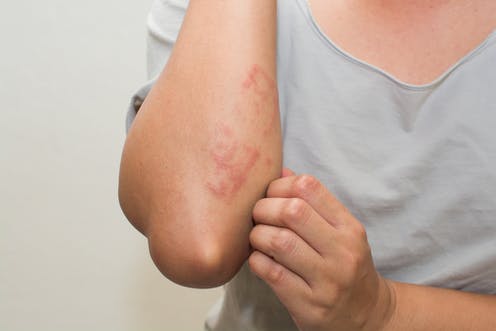Symptoms and Causes
Shingles, also called herpes zoster, is a pathological infection that causes one to have painful rashes with blisters on the body. This infection mostly occurs as a stripe of sores that wraps around your torso or face. The disease’s cause a virus known as varicella-zoster. The virus also causes chickenpox.
Its symptoms may include some pain and burning of the affected area on your body, a red rash appearing a few days after the problem, and some blisters that break open. Some shingle-infected people may also get a headache, fever, maybe light-sensitive, and develop fatigue.
Spread of the Infection

The infection is not transmittable. However, the virus that causes the disease, varicella-zoster, is. Transmission can only occur through direct contact of a person that is not immune to chickenpox with the open sores of a person’s rash. Once the person has the virus, he or she will develop chickenpox instead. Then the person could develop the infection later in his or her life.
This is mainly because after one’s recovery from chickenpox, the virus stays dormant in their body. If an immune weakening disease attacks the person again, the virus becomes active and causes shingles. The risk of spreading the condition is, however, low if the rashes are well covered. One should also note that people with chickenpox are more likely to spread the virus than with shingles.
Factors that Increase the Risks of Infection
Any person who is not immune to chickenpox can get the virus, but some people have a higher chance of getting it than others. This risk of transmission is sometimes increased by medical conditions that sabotage a patient’s immune system. These conditions include cancer, lymphoma, leukemia, and human immunodeficiency virus (HIV). Taking drugs that sometimes keep the immune system from working correctly also increases the risk. These drugs may be steroids or medications given to a patient after organ transplantation.
Another person at a higher risk of getting the disease is one who had chickenpox previously. This shingle-infection incidence increases with age so that older people are at a higher risk of getting the infection much more than children.
This, however, is not the case with children whose mothers had chickenpox during the last 5 to 21 days of their pregnancies. These children have a higher risk of pediatric infections of the disease. These children are sometimes born with chickenpox or develop chickenpox within a few days after birth.
Cancer treatments are a factor that increases one’s risk of contracting the infection. Chemotherapy can lower your immune system’s resistance to certain diseases hence triggering varicella’s activities.
Postherpetic Neuralgia
 This is the condition where the infection pains persist for a long time, especially in older people. This pain lasts for more than three months after the onset of the rashes. This pain leads to sleeplessness in patients, weight loss, and sometimes disabilities. Other complications may include cold and loss of feeling.
This is the condition where the infection pains persist for a long time, especially in older people. This pain lasts for more than three months after the onset of the rashes. This pain leads to sleeplessness in patients, weight loss, and sometimes disabilities. Other complications may include cold and loss of feeling.
Postherpetic neuralgia is not a life-threatening condition, and it usually gets better in time. There are a lot of medications prescribed and shown to provide some pain relief for the patients. These include opioids, topical local anesthetics, anticonvulsants, among others.
Opioids relieve all types of pain. They have some side effects such as drowsiness, constipation, and addiction. Patients need monitoring when using them. Anesthetics are effective when applied directly to the skin’s painful area affected by postherpetic neuralgia. Anticonvulsants act against the condition by reducing seizures and pains.
Prevention and Treatment
If an individual takes the chickenpox vaccine before getting chickenpox, he or she prevents the infection. If the individual already had the primary infection, then vaccines are made for the disease to reduce its risks.
The purpose of these treatments could be to limit the duration and severity of pain, reduce complications in patients, and shorten the period a patient lives with the infection. Though there is currently no cure for it, doctors administer antiviral drugs as soon as the symptoms begin. These early treatments help prevent or reduce pain and even help the blisters heal faster.

When the eye or any other facial nerves suffer from the infection, other treatments such as taking anti-inflammatory corticosteroids, is advisable.
In the case where a patient has inflammations and has developed skin complications, EMUAIDMAX is the solution. The ointment kills fungus, and 99.99% of bacteria on contact in less than a minute. It also helps in calming pain, infections, and inflammations, plus dealing with a ton of other skin complications. EMUAIDMAX is a staple remedy known for its therapeutic ingredients that aid in anti-inflammatory and antimicrobial healing.
Infected people should try to relax and reduce stress. Stress tends to make the pain worse and lead to depression. They should eat well-balanced meals regularly and perform exercises such as stretching to keep themselves active and occupied and be distracted from the pain. Placing a cold and damp wash-cloth on blisters can help relieve the pain and help the blisters dry and heal faster. Keeping the areas around the patient’s blisters can help minimize or avoid secondary bacterial infection and give faster healing.
To prevent spreading the infection to others, you should cover the rashes. Wash your hands often and avoid contact with pregnant women who have never had chickenpox or the chickenpox vaccine. It would be best to avoid contact with premature or low-birth-weight infants and people with weak immune systems such as those undergoing chemotherapy, organ transplant recipients, and those with HIV.
References
Kernich, Catherine A. MSN, RNC. (2007) The Neurologist: Volume 13 – Issue 1 – p 43-44. doi: 10.1097/01.nrl.0000253099.08972.d1
